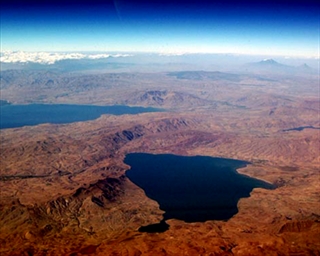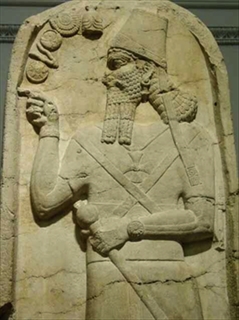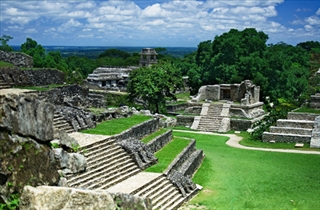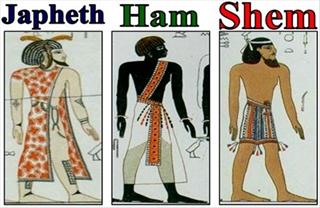 Lake Van, Mount Ararat, Turkey
Lake Van, Mount Ararat, TurkeyThis is the record of Babylonians, not the possessors of the Old Testament, the Jews. The Babylonians had no interest in historical agreement with their rivals, the Jews. And yet, both nations agree on the time of the founding of Babylon.The ancient Babylonians are said to have begun building their impressive structures about 3000 B.C. However, a king of Babylon, Nebuchadnezzar, wrote on a plaque that was discovered at the ruins of an ancient tower, that he (Nebuchadnezzar) had refurbished this tower which originally was nearly completed by the first king of Babylon, but could not be completed because the builders could no longer understand one another words.
Nebuchadnezzar further in-scripted on the plaque that this first king ruled 42 generations before about 500 B.C. Here an ancient king of Babylon stated that Babylon began about 2200 B.C. This time frame fits that presented in the Bible; Nimrod, occultist and rebel against God, was the first king of Babylon, about 200 years after the Flood.
(1) Legends of this historical event abound from disparate people groups from around the world. Astronomical records, obtained by Alexander the Great from the Babylonians, are dated back 1903 years from 331 B.C. The Babylonians told Alexander that Babylon began when the astronomical records began, in 2234 B.C.
"And it came to pass, as they journeyed from the east, that they found a plain in the land of Shinar; and they dwelt there." - Genesis 11:2
Using the biblical narrative as the blueprint we can assume they would of traveled along a river using common sense for survival purposes and watering their flocks. It seems that the migrants began their journey at the beginning of the mountain streams that was a tributary of the Euphrates River near the area of the Ark, and followed it to the west until they came to a plain. Topographical and flight maps of the region show where the Euphrates River exits the mountainous region – roughly a 250 mile journey from the region of the Ark. And there where the mountains end, one finds a tremendous plain. Another route they could also have taken would have brought them to the same plain but by an easier and more direct path. This second route would have taken them in a south-west direction for about 140 miles until they reached the west side of Lake Van. From there, they would have traveled along a river about 50 miles through a mountain pass, to exit onto the vast plain. Here they could travel west until they reached the Euphrates. These are the only two natural east-west routes across Anatolia.
(2)
 ancient sculpture of Nimrod
ancient sculpture of NimrodThe historian Josephus twice referred to Nimrod as one who ruled by "tyranny." This is more apt than perhaps Josephus realized, although it is likely he chose the term by design, writing as he did in Latin. The English words "tyranny" and "tyrant" (despot, oppressor, dictator, autocrat) derive from the Latin "taurus" (bull) which in turn comes from the ancient Sumerian word "tur" (bull). The Sumerians knew him as Gilgamesh, the great hero and "half-mortal king of Uruk.
(3) In the Sumerian legend, built around Nimrod, Gilgamesh was a renowned tyrant-king, "terrifying like a great wild bull".
(4)
He was sometimes hated for his tyranny but also revered as the superman who had defeated the legendary Bull of Heaven and taken away its horns.
(5) Gilgamesh was the son of the "Divine Lugulbanda" (Cush)and "Mother Ninsun.".
(6) Gilgamesh "became a god after his death." In his other but similar Sumerian guise he was called Dumuzi, the "Wild Bull," king of Uruk, son of Lugalbanda and Ninsun the cow-goddess.
(7) The earliest representations of this hero in Sumer are of a normal but extremely powerful man who kills bulls and lions with his bare hands, and who thereafter absorbs their powers into his own body so that his feet become hooves, his head has horns and his body flourishes a tail. Sound familiar? Many clay tablets and cylinder seals of this famous bull-man have been found by archaeologists who appeared to be baffled by his identity. The bull-legged man of Mesopotamia may well head a long line of mysterious progenyhe has not lost his appeal to this day. On cylinder seals the hero and bull-man appear together a motif that is repeated in endless variations but for which there is no explanation to be found in myth or lore.
(8)
In the Sumerian city of Uruk according to the Sumerian king lists, Dumuzi and Gilgamesh were the fourth and fifth of the first five kings of Uruk who ruled after the flood. The next seven kings were portrayed as fairly normal and mortal men, but the first five were deified into mythical gods, with many supernatural powers added to their reputations, which exaggerated and confused their real identity. Nevertheless, the noted Mesopotamian archaeologist Sir Leonard Wooley, when considering these legendary kings, concluded that beneath their names "lurks something of fact."
(9)
 Mayan Ruins
Mayan RuinsIxtlilxochitl; the Mexican chronicler records another ancient Toltec tradition that the descendants of the flood survivors built a “zacuali” (tower) of great height. Everyone spoke the same language. After this, their tongues became confused and, no longer able to understand one another, they went to different parts of the world. After some time, the seven families who spoke the Toltec language set out for the New World. They wandered 104 years over large extents of land and water. Finally they arrived at Huehue Tlapallan in the year One Flint, 520 years after the flood.
(5)
The Popul Vuh, a book of the Central American Maya likewise refers to the original one language. It states that “those who gazed at the rising of the sun [the ancestors who formerly lived eastward of the Americas]… had but one language… before going west.” In his book on the origin of the Maya, Votan declares himself a descendant of Imos, of the land of Chan, of the race of Chivim. Research shows that present-day Tripoli in Syria was anciently known as Chivim. This was only 150 miles (240 kilometers) from the site of the Babel tower where the one language was suddenly split up into a confused mixture, generating a dispersion of the people. A copy of Votan’s book, written in the Quiche language, existed until 1691, when it was very likely burned, along with other native relics, by the Spaniards at Huehuetan, but not before extracts had been copied from it.
 The sons of Noah
The sons of NoahAccording to the fourth century historian Eusebius of Caesarea, Egialeus, the first king in Greece, began his reign in 2089 B.C., 1313 years before the first Olympiad in 776 B.C.
(1) Homer, in his Iliad, shows us that the Greeks likewise recollected three brothers. To each was given a domain when the world was divided. The Greeks trace themselves back to Japetos. Yet, it's heard Greece and the other civilizations are older than indicated because of faith in the flawed carbon results and their Darwinian philosophy.
(10) The Byzantine chronicler, Constatinius Manasses, wrote that the Egyptians state lasted 1663 years. If correct, then counting backward from the time that Cambyses, King of Persia, conquered Egypt in 526 B.C., gives us the year 2188 B.C (56 years after the birth of Peleg). for the founding of Egypt.
Menes, the legendary founder of Egypt, is the Misraim (Hebrew) or Mestre (Greek) of the second generation from Noah. Once again the Biblical time frame matches.
(1) Historians even corroborate this pre flood world where the Bible says people lived 800-900 years. The following pagan ancient historians mention much longer life spans in a previous age: Hestiaeus, Mochus, Berosus, Manetho, Hieronymus, Hesiod, Hecataeus, Ephorus, and Nicolaus. So you see that secular history actually corroborates the most accurate history book ever written, the Bible. The Ancient Chinese will be in a future article by themselves. The manner in which there history has been preserved and passed down will deserve and need an article all to itself, but will say that The first solar eclipse ever recorded happened in 2134 B.C. In China.